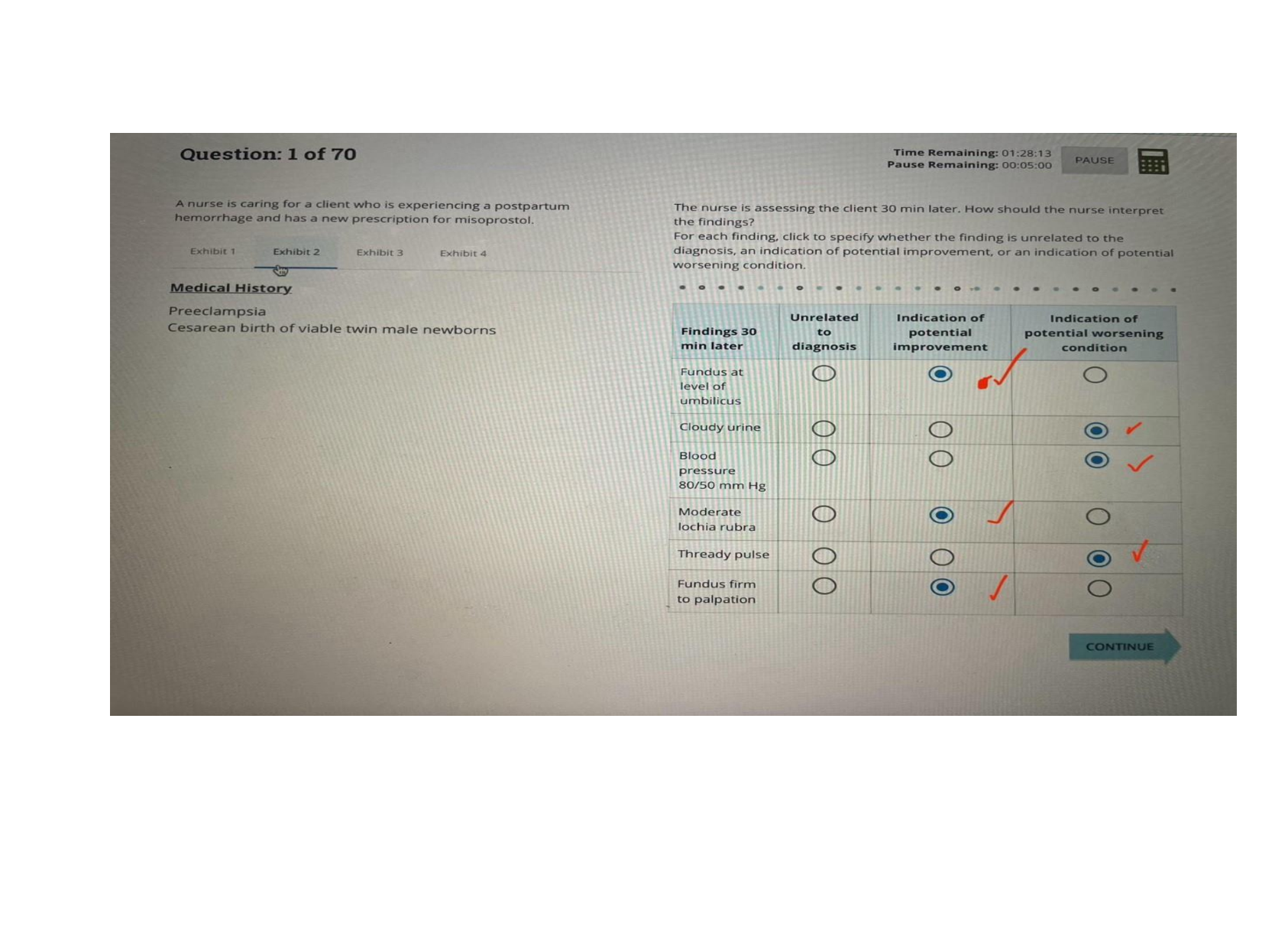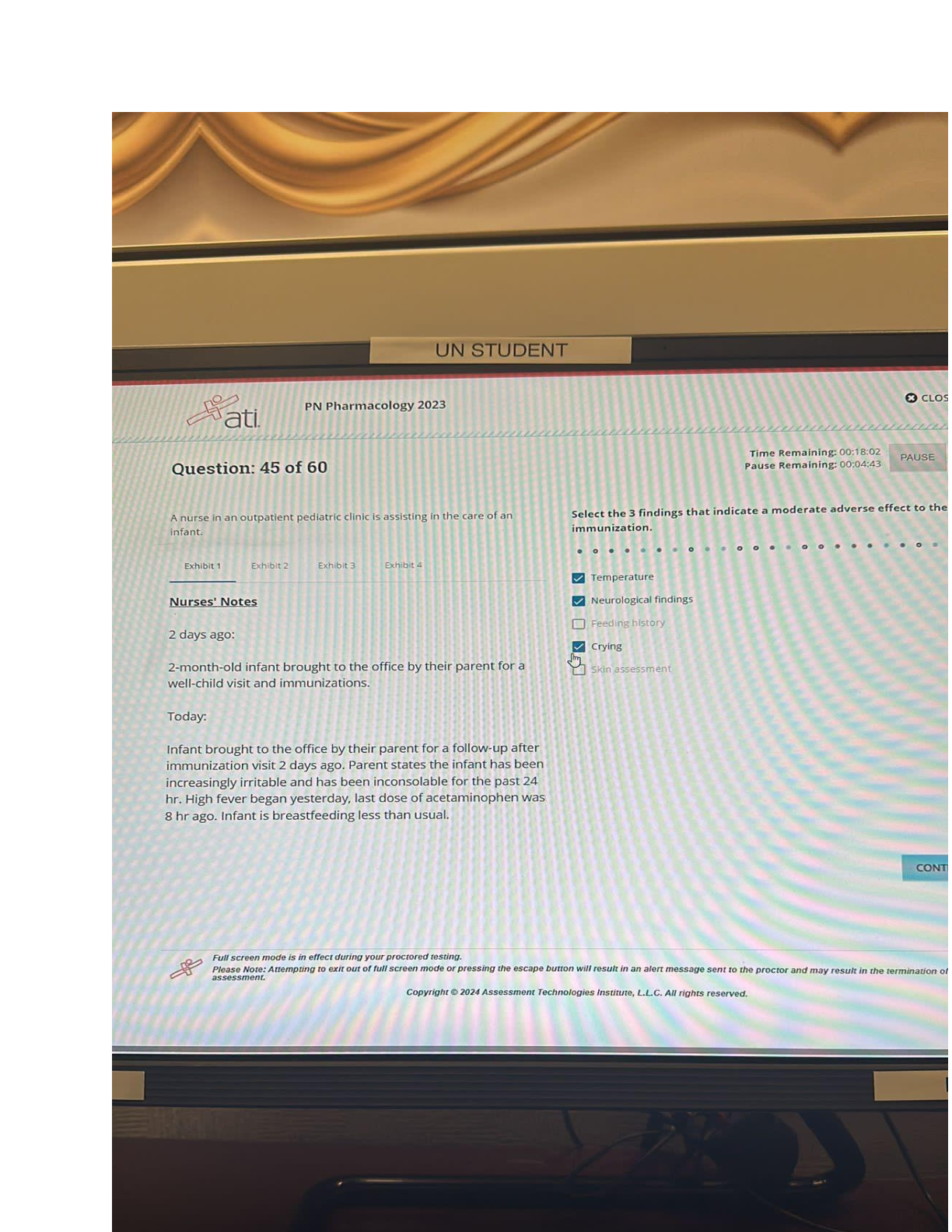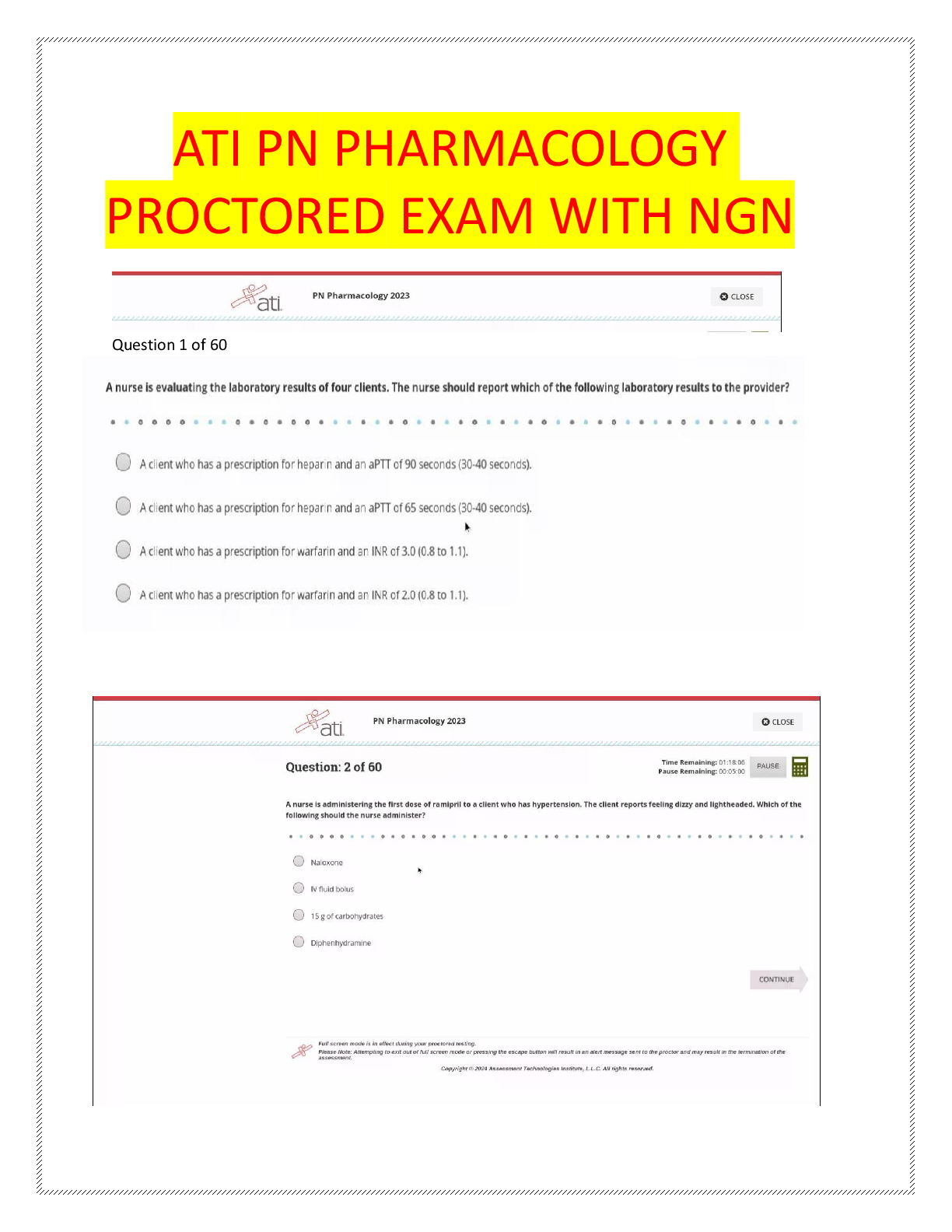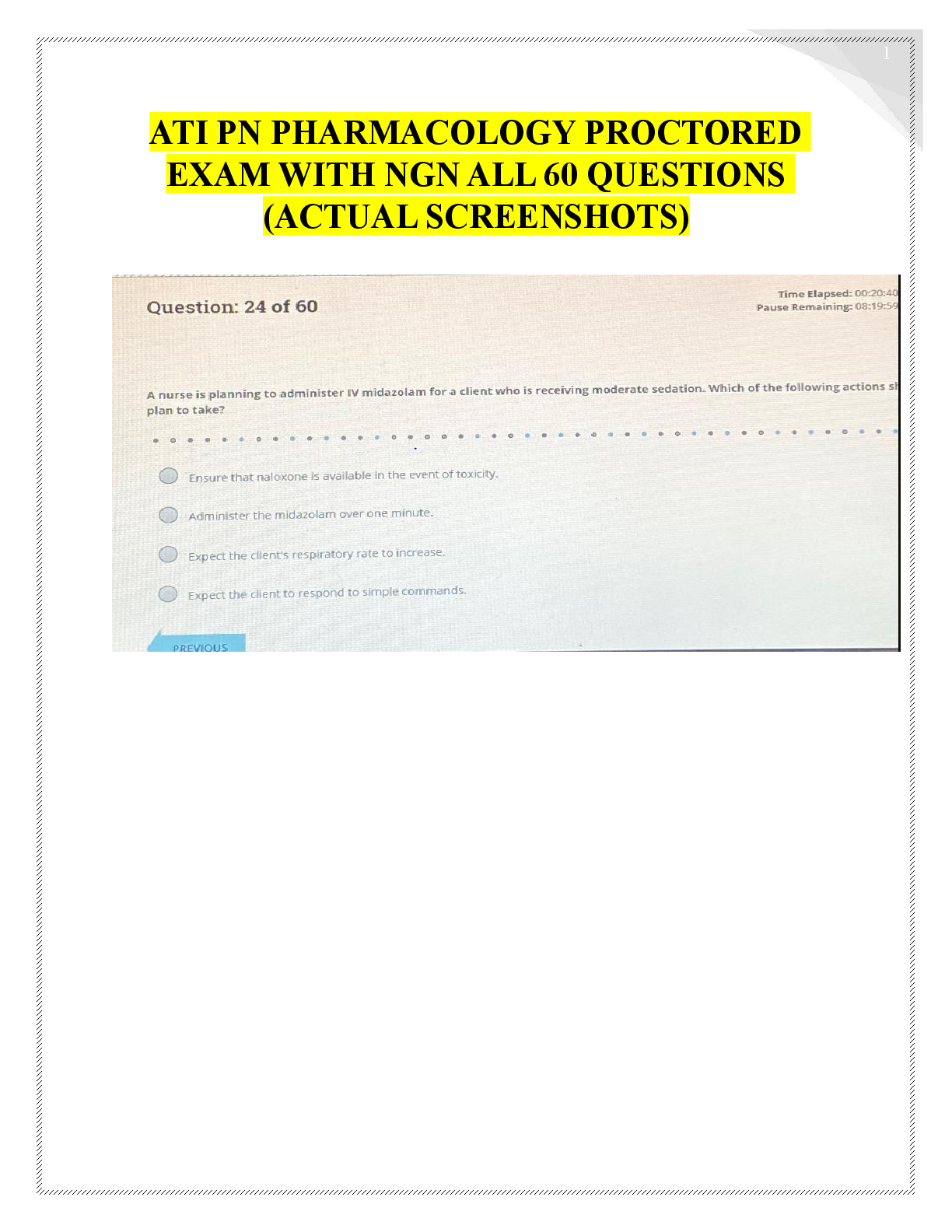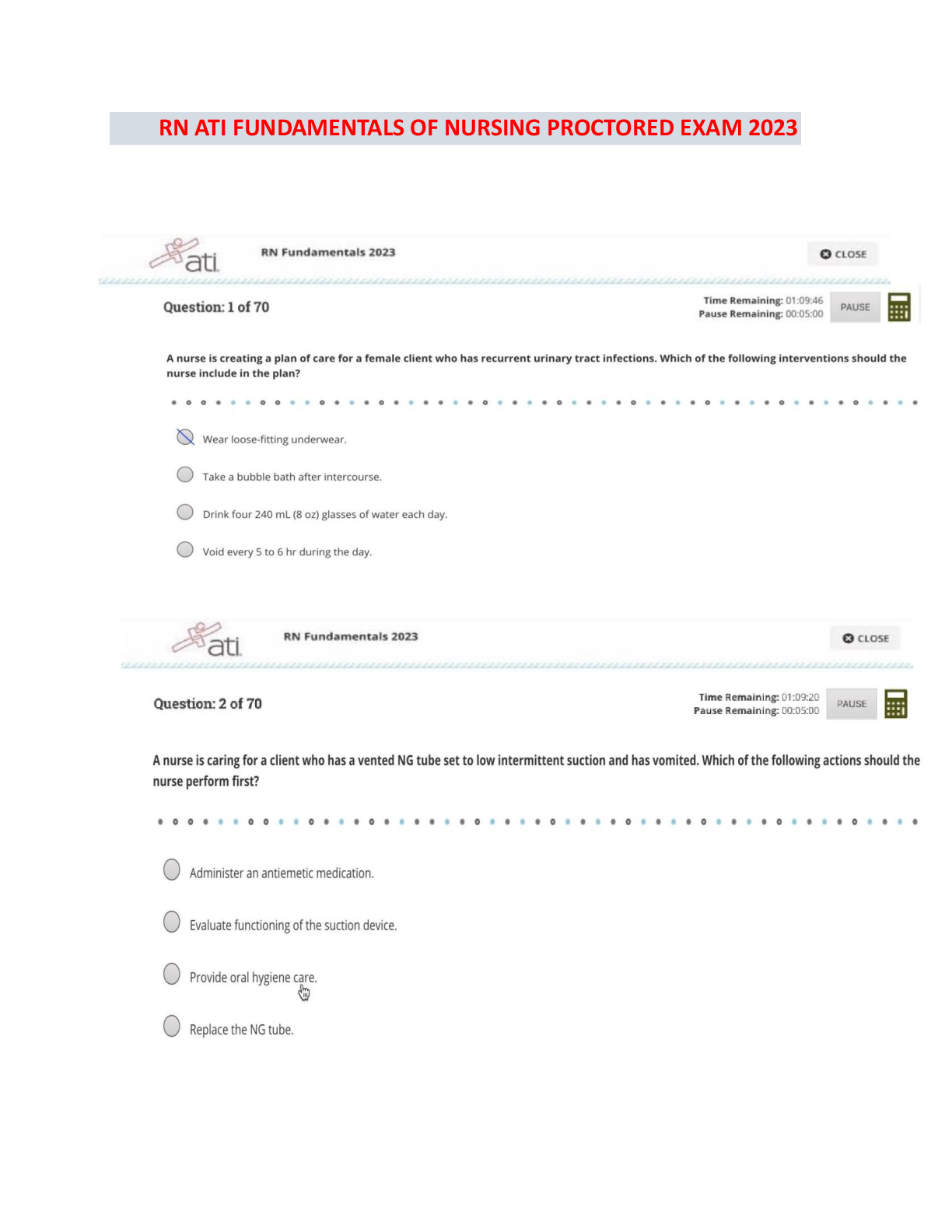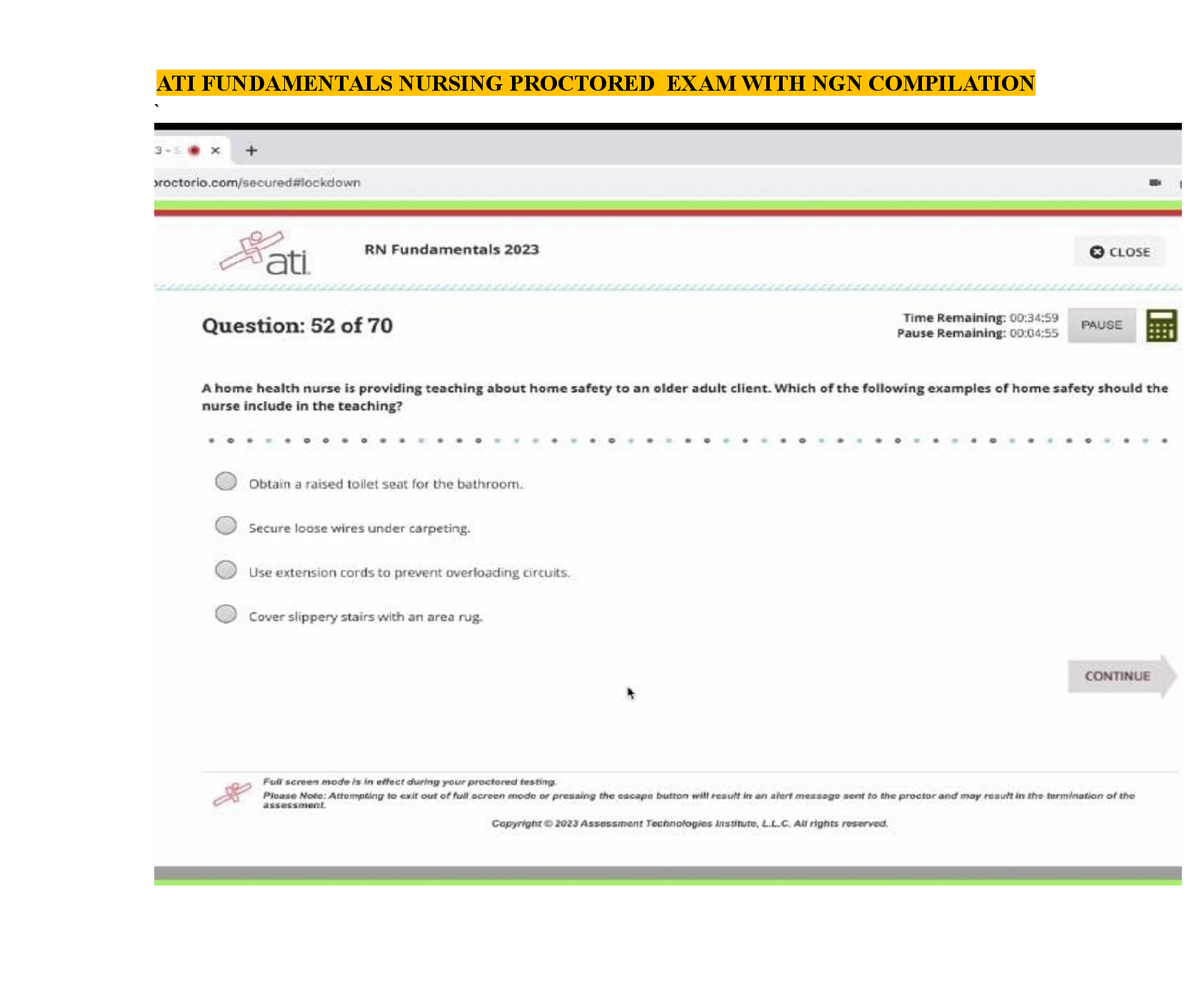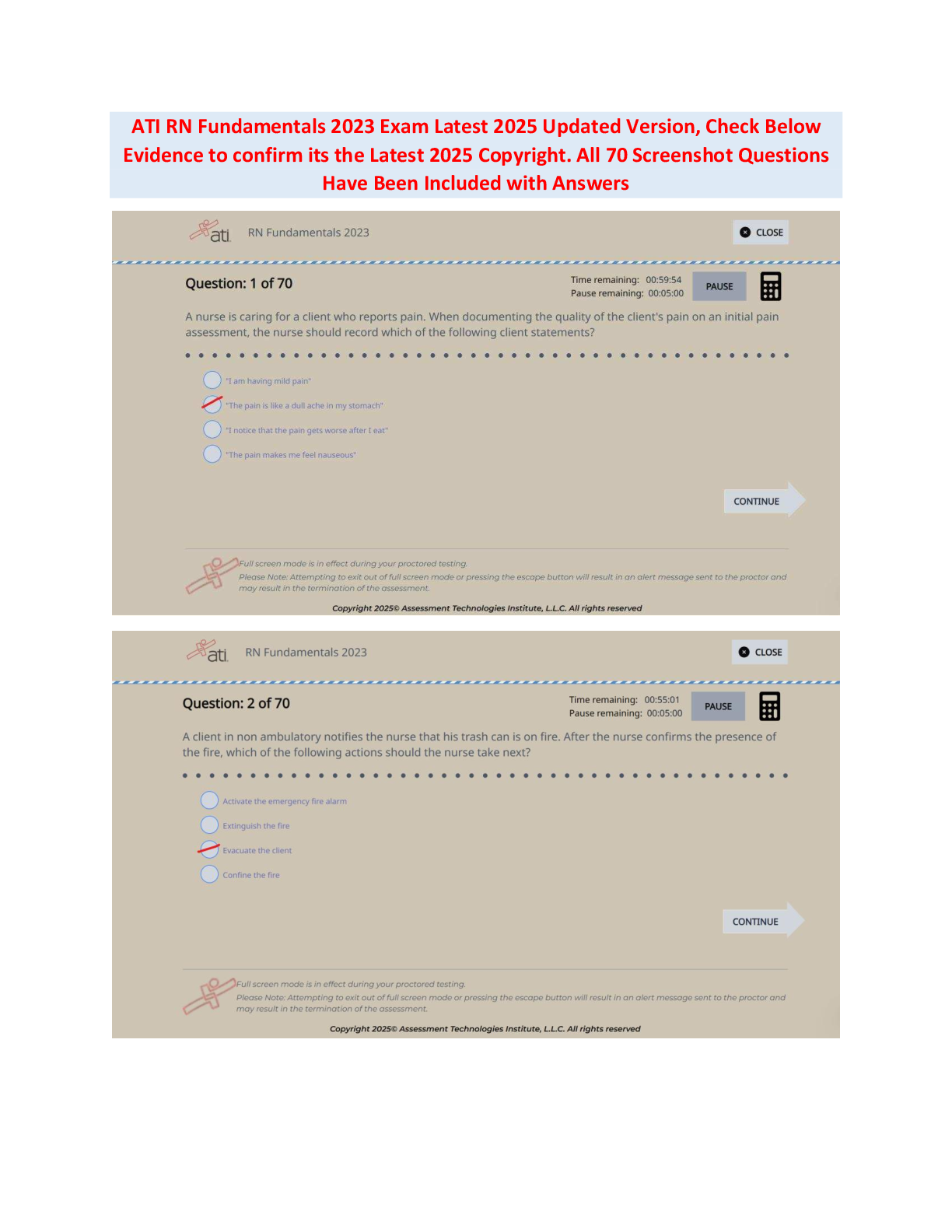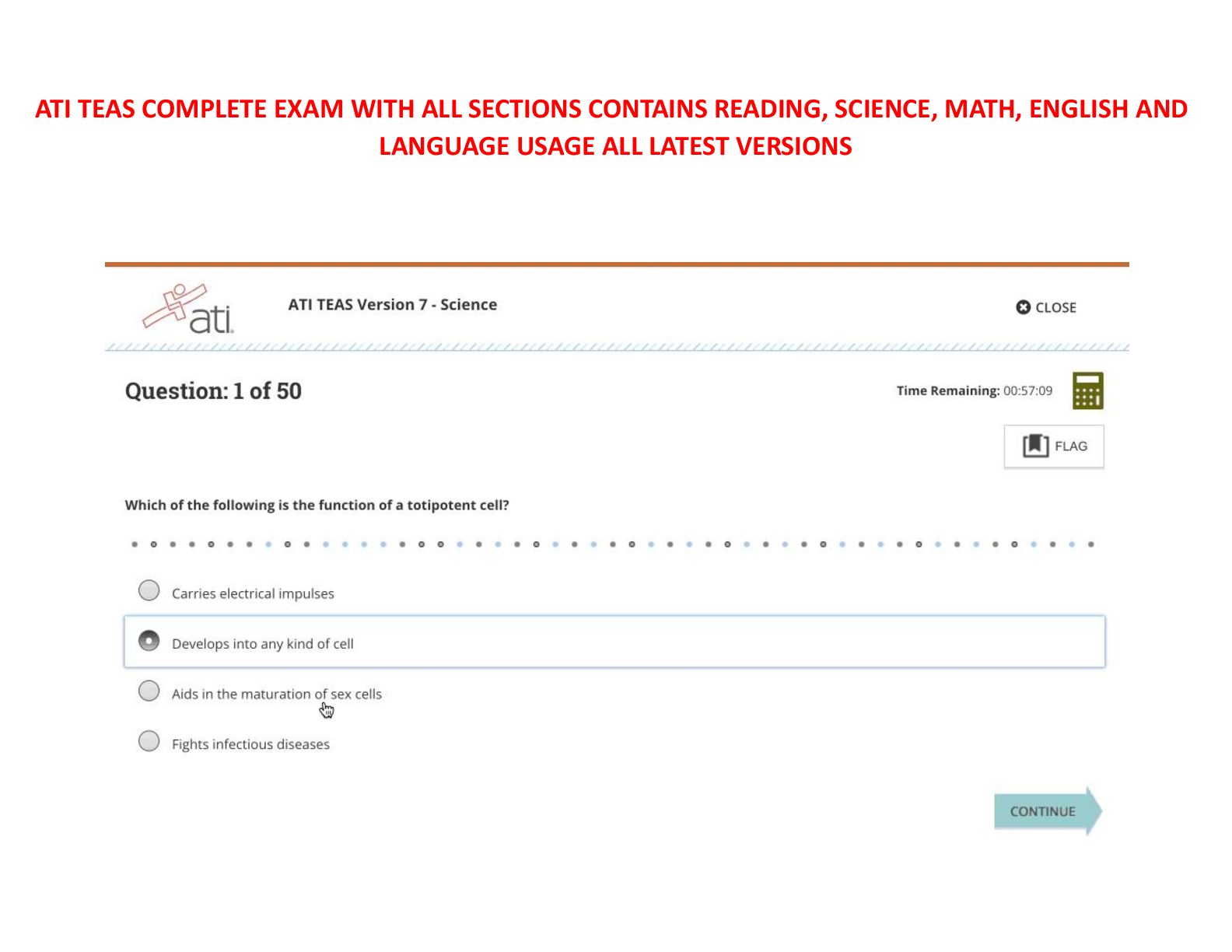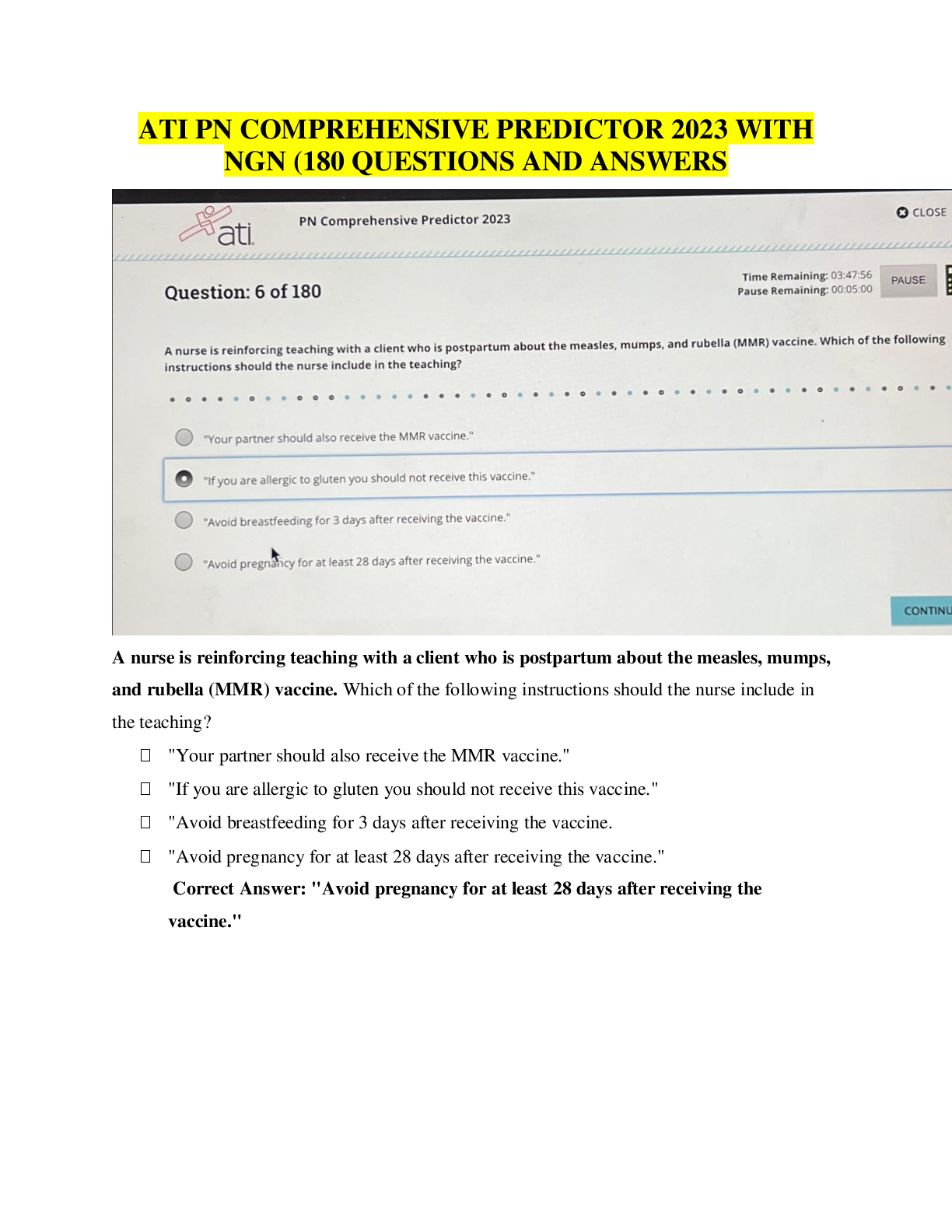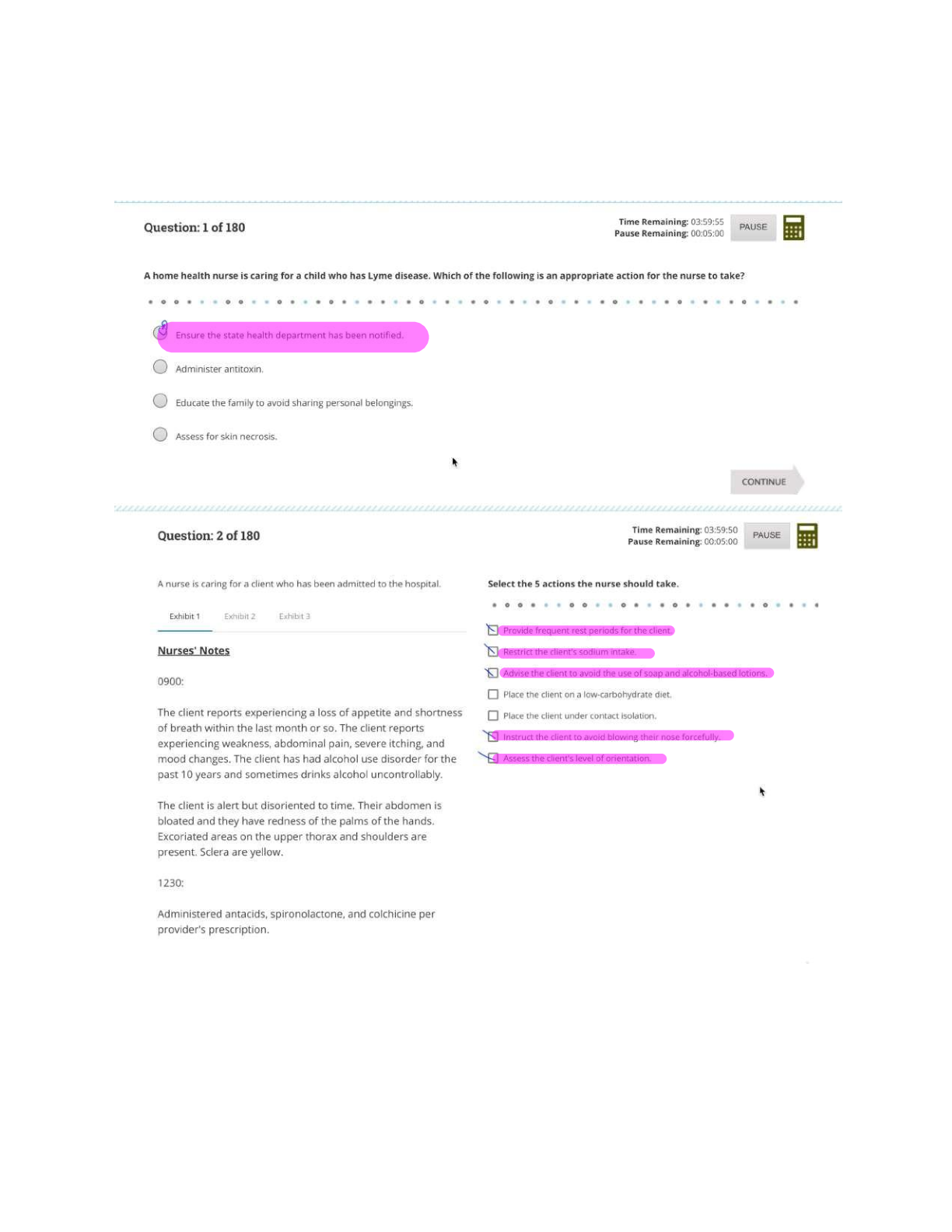*NURSING > EXAM PROCTORED > Pediatric Proctored Exam | Contains 70 Questions and Answers (All)
Pediatric Proctored Exam | Contains 70 Questions and Answers
Document Content and Description Below
Pediatric Proctor (2016) (70/70 Questions) 1. A nurse is preparing to assess a 4-year old child’s visual acuity. Which of the following actions should the nurse plan first? Use a tumbling E c ... hart for the assessment Position the child 4.6 meters (15 feet) from the chart Assess both eyes together first, then each eye separately Test the child without glasses before testing with glasses 2. A nurse is providing discharge teaching to a parent of a child who has juvenile idiopathic arthritis and a new prescription of prednisone/etarnecept. Which of the following statement should the nurse include in the teaching? “Discontinue this medication if gastrointestinal upset occurs.” “Expect that this medication will stimulate a growth spurt.” “Limit your child’s intake of potassium-rich foods.” “Monitor your child for indications of infection.” 3. A nurse on a pediatric unit is caring for four children. The nurse should use droplet precautions for which of the following children? An adolescent who has hepatitis A A toddler who has seasonal influenza A preschool-age child who has pediculosis capitis A school-age child who has viral conjunctivitis 4. A nurse is providing teaching to an adolescent who has vulvovaginitis. Which of the following statements should the nurse include in the teaching? “Apply a warm, moist compress three times per day.” “Apply scented baby powder to absorb residual moisture.” “Wear a feminine deodorant pad for vaginal drainage.” “Wear nylon underwear at night.” 5. A nurse is creating a plan of care for a school-age child who has nephrotic syndrome. Which of the following interventions should the nurse include? (Select all that apply) Provide a low-sodium diet Encourage increased fluid intake Assess for protein in the urine Initiate contact precautions Obtain a daily weight 6. A nurse in a pediatric unit is caring for a school-age child following a cardiac catheterization. Which of the following interventions would the nurse take? Maintain NPO status for 24 hrs. following the procedure Administer meperidine for pain every 4 hrs. Perform a sterile dressing change 8 hrs. after the procedure Keep the affected extremity straight for 6 hrs. 7. A nurse is teaching a parent of a toddler about administering digoxin. Which of the following statements by the parent indicates understanding of the teaching? “I should mix the medication with 4 ounces of my child’s favorite juice.” “I should give my child water after giving the medication.” “I should give my child another dose if he vomits right after taking the medication.” “I should give the medication with foods that are high in fiber.” 8. A nurse is caring for a 9-year-old child who has major burns to her face and upper torso. Which of the following actions should the nurse take first? Administer a tetanus vaccine Give pain medication Begin enteral feedings Initiate a crystalloid IV bolus 9. A nurse is planning care for a toddler who has developed oral ulcers in response to chemotherapy. Which of the following should the nurse include in the plan of care? Schedule routine oral care every 8 hrs. Administer oral viscous lidocaine Moisten the mucous with lemon glycerin swabs Cleanse the gums with saline soaked gauze 10. A nurse in a community health clinic is assessing the needs of a single parent who has three young children and works full time. Which of the following resources should the nurse recommend? 12-step support group Respite child care Child home health care Counseling for depression 11. A nurse is caring for a child who has a prescription for fluticasone and has developed white patches and sores in his mouth. Which of the following is an appropriate action for the nurse to take? Encourage the use of a spacer Withhold the medication until the lesions heal Obtain a prescription for oral prednisone Collect a culture from the lesions 12. A nurse is providing teaching to the parents of a child who has impetigo. Which of the following instructions should the nurse include in the teaching? Seal soft toys in a plastic bag for 14 days Apply bactericidal ointment to lesions Administer acyclovir PO two times per day Soak hairbrushes in boiling water for 10 min. 13. A nurse in an emergency department is caring for a child who has epiglottis. Which of the following actions should the nurse take? Provide nebulizer aerosol therapy Administer IV antibiotics Inspect the tonsils using a tongue depressor Collect a throat culture 14. A nurse is planning care for a child who is placed in skin traction. Which of the following is the priority action for the nurse to take? Increase fluid intake Maintain proper body alignment Use an alternate pressure mattress Monitor pedal pulses 15. A nurse is preparing to administer ondansetron 0.15 mg/kg IV to a child who is receiving chemotherapy and weighs 29.4 kg. Available is ondansetron 4 mg/2 mL solution. How many mL should the nurse administer? (Round the answer to the nearest tenth. Use a leading zero if it applies. Do not use a trailing zero) Answer: 2.2 mL 16. A nurse is performing a physical assessment of a school-age child who has acute glomerulonephritis. Which of the following findings should the nurse expect? Hypotension Increased urinary output Flushed skin Facial edema 17. A nurse in an emergency department is assessing an adolescent who reports inhalation of gasoline. Which of the following findings should the nurse expect? Hypothermia Pinpoint pupils Hyperactive reflexes Ataxia18. A nurse in the emergency department is assessing a toddler who has hyperpyrexia, severe dyspnea, and is drooling. Which of the following actions should the nurse take first? Prepare the toddler for nasotracheal intubation Insert an IV catheter for the toddler Obtain a blood culture from the toddler Administer an antibiotic to the toddler 19. A nurse is caring for an infant who has a patent ductus arteriosus. The nurse should identify that the defect is at which of the following locations of the heart? (You will find hot spots to select in the artwork below. Select only the hot spot that corresponds to your assessment) Answer: 20. A nurse is caring for an infant who has hydrocephalus and ventriculoperitoneal shunt malfunction. Which of the following assessment findings indicates that the infant is experiencing increased intracranial pressure? Increased appetite Irritability Flat fontanel Tachycardia 21. A nurse is assessing an infant who has iron deficiency anemia. Which of the following findings should the nurse expect? Increased hemoglobin level Hyperactive muscle tone Bradycardia Pale conjunctiva 22. A nurse is caring for a child who received partial thickness burns to over 50% of his body 10 days ago and has splints over his joints to prevent contractions. Which of the following actions should the nurse take? (Select all that apply) Provide a high-calorie diet Administer analgesics IM Remove splints during sleep Change dressings using aseptic technique Monitor intake and output23. A school nurse is assessing a 7-year-old student. The nurse should identify which of the following findings as a potential indicator of physical abuse? Bruising around the wrists Abrasions on the knees Weight in 45th percentile Front deciduous teeth missing 24. A nurse is assessing an 18-month-old child during a well-child visit. Which of the following findings should the nurse report to the provider? The child crawls to navigate the room The child has frequent temper tantrums The child consistently throws items to the floor The child scribbles on the wall with a crayon 25. A nurse is caring for an infant who has rotavirus. Which of the following findings indicates that the infant is inadequately dehydrated? Weight loss 7% Capillary refill 1 second Bradycardia Respiratory rate 26/min 26. A nurse is providing teaching about injury prevention to the parents of a toddler. Which of the following safety measures should the nurse include in the teaching? Adjust the water heater temperature to 54° C (129.2° F) Check clothing for loose buttons Provide balloons for play Place screens on all windows 27. A nurse is caring for a school-age child who is in 90°/90° skeletal traction. Which of the following actions should the nurse take? Release the traction to allow the child to bathe Place the child on an alternating pressure mattress Adjust the weights to allow the child to turn Ensure that the pulley mechanism is attached to the skin 28. A nurse is caring for a child who has increased intracranial pressure and is unconscious due to a closed head injury. Which of the following actions should the nurse take? Maintain the child’s neck in a flexed position Turn the child side to side every 2 hrs. Initiate seizure precautions Perform chest percussion as needed 29. A nurse is providing teaching to the parents of a school-age child newly diagnosed with a seizure disorder. The nurse should teach the parents to take which of the following actions during a seizure? Clear the area of hard objects Minimize movement of the limbs Insert a tongue blade between the teeth Place the child in a prone position 30. A nurse is providing teaching to a parent of an infant who has diaper rash. Which of the following statements by the parent indicates an understanding of the teaching? “I will use antibacterial soap to wash the rash with each diaper change.” “I will keep the area warm and moist.” “I will use super-absorbent disposable diapers.” “I will sprinkle talcum powder over the affected area twice daily.” 31. A nurse in a provider’s office is assessing the vital signs of a 1-year-old toddler. Which of the following findings should the nurse report to the provider? Blood pressure 88/42 mm Hg Heart rate 110/min. Respiratory rate 54/min. Temperature 37.7° C (99.9° F) 32. A nurse is teaching about growth and development to a parent of a 12-year-old child. The nurse should instruct the parent to expect the child to exhibit which of the following characteristics during early adolescence? Emotional separation from parents Mood swings Increased self-esteem Decelerating growth rate [Show More]
Last updated: 1 year ago
Preview 3 out of 13 pages

Loading document previews ...
Buy this document to get the full access instantly
Instant Download Access after purchase
Buy NowInstant download
We Accept:

Reviews( 0 )
$8.00
Can't find what you want? Try our AI powered Search
Document information
Connected school, study & course
About the document
Uploaded On
Apr 28, 2021
Number of pages
13
Written in
All
Additional information
This document has been written for:
Uploaded
Apr 28, 2021
Downloads
0
Views
109




